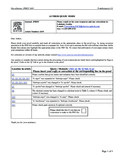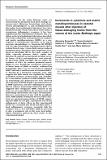Buscar
Mostrando ítems 1-10 de 69
Proteomic and functional profiling of the venom of Bothrops ayerbei from Cauca, Colombia, reveals striking interspecific variation with Bothrops asper venom
(Journal of Proteomics Volume 96, 16 January 2014, Pages 159–172, 2014-01)
Bothrops ayerbei, a pitviper inhabiting the Patía River's basin (Valle Alto del Río Patía) in the Southwestern Department of Cauca, Colombia, was considered as a variant form of Bothrops asper prior to being proposed as a ...
Snake Venomics of the Lesser Antillean Pit Vipers Bothrops caribbaeus and Bothrops lanceolatus: Correlation with Toxicological Activities and Immunoreactivity of a Heterologous Antivenom
(2008-10)
The venom proteomes of the snakes Bothrops caribbaeus and Bothrops lanceolatus, endemic to the
Lesser Antillean islands of Saint Lucia and Martinique, respectively, were characterized by reversephase
HPLC fractionation, ...
Unresolved issues in the understanding of the pathogenesis of local tissue damage induced by snake venoms
(2018-06)
Snakebite envenoming by viperid species, and by some elapids, is characterized by a complex pattern of
tissue damage at the anatomical site of venom injection. In severe cases, tissue destruction may be so
extensive as ...
Hemorrhage induced by snake venom metalloproteinases: biochemical and biophysical mechanisms involved in microvessel damage
(2005-06-15)
Zinc-dependent metalloproteinases are responsible for the hemorrhagic activity characteristic of viperid snake venoms. Snake venom metalloproteinases (SVMPs) are classified in various groups (P-I–IV), according to their ...
Pathological alterations induced by neuwiedase, a metalloproteinase isolated from Bothrops neuwiedi snake venom
(2001-06)
The pathological alterations induced by neuwiedase, a 22 kDa class P-I metalloproteinase from the venom of the South American pit viper Bothrops neuwiedi, were studied in mice. Neuwiedase was devoid of hemorrhagic activity ...
Skin Pathology Induced by Snake Venom Metalloproteinase: Acute Damage, Revascularization, and Re-epithelization in a Mouse Ear Model
(2008-10)
Viperid snakebite envenomation induces blistering and dermonecrosis. The pathological alterations induced by a snake venom metalloproteinase in the skin were investigated in a mouse ear model. Metalloproteinase BaP1, from ...
Bothrops asper metalloproteinase BaP1 is inhibited by alpha(2)-macroglobulin and mouse serum and does not induce systemic hemorrhage or coagulopathy
(2004-02)
The ability of the P-I metalloproteinase BaP1, isolated from the venom of the snake Bothrops asper, to induce systemic bleeding, thrombocytopenia and defibrinogenation was assessed in an experimental mouse model. Intravenous ...
Increments in cytokines and matrix metalloproteinases in skeletal muscle after injection of tissue-damaging toxins from the venom of the snake Bothrops asper
(2002)
Envenomations by the snake Bothrops asper are characterized by prominent local tissue damage (i.e. myonecrosis), blistering, hemorrhage and edema. Various phospholipases A2 and metalloproteinases that induce local pathological ...
Experimental pathophysiology of systemic alterations induced by Bothrops asper snake venom
(2009-12-01)
Moderate and severe envenomations by the snake Bothrops asper provoke systemic alterations, such as systemic bleeding, coagulopathy, hypovolemia, hemodynamic instability and shock, and acute renal failure. Systemic hemorrhage ...
Systemic effects induced by the venom of the snake Bothrops caribbaeus in a murine model
(2013-03)
Snakebite envenoming by Bothrops caribbaeus, an endemic viperid from the Lesser Antillean island of Saint Lucia, is clinically characterized by local tissue damage and systemic thrombosis that can lead to cerebral, myocardial ...



